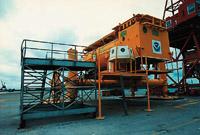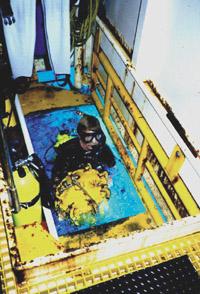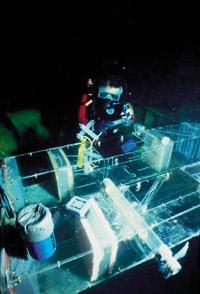Aquarius: seabed space station

We spent hours looking into outer space and spent millions and millions on their research. But there is no need to go so far to find unexplored mysterious places. Here, on Earth itself, the oceans covering two-thirds of the surface of our planet are also quite unknown. Aquarius is an underwater laboratory built in the waters of Florida to solve all these mysteries.
Although Aquarius managers are interested in the name of the seabed space station, the poxpole box of the seabed could also be a good name, perhaps the whim, for the laboratory located on the Florida seabed. But, aside from names and accounts, let's know what a special laboratory is for and for.
Aquarius is the legacy of the ambitious seabed research program launched by the US government in the 1960s. Helgoland, Klobuck, Subigloo, Hydrolab and so up to 60 were habitats before Aquarius. At that time he dreamed of underwater cities and marine research began with as much passion as space research. Eventually, however, the astronauts won and as space programs grew, interest in the sea went off. Currently, the money spent on a space mission would secure 500 years of maintenance in Aquarius.
How is Aquarius?
Aquarius is a yellowish construction of 12 m in length and 3 m in diameter. The cylinder has a weight of 80 tons and is tied to a base of 116 tons. Thanks to this, the seabed remains stable at about 20 m depth. The steel house consists of 3 compartments connected by watertight doors: wet porches, entrances and lounges.

Wet porch: Sea entrance of Aquarius. Divers enter and exit through a door on the floor of this room and, while outside, the door is always open. The pressure inside and outside the room is the same, so the water does not enter the interior of Aquarius and the stay remains dry at all times.
Air bottles and other divers' materials are stored in it and, in turn, air pressure and gas flow are controlled from this compartment in other Aquarium rooms.
Entrance: already part of the main cylinder, next to the wet porch. It is a very small compartment and is mainly used as a warehouse.
Living room: It is the main room of Aquarius, where researchers live, eat, sleep and work. It is divided into two parts: a work area with all the necessary equipment, such as computers and videos; and another area of residence, also well equipped: in addition to six bunk beds for sleeping, the dinner table, the microwave, the cupboards for food and everything necessary for a "comfortable" life.

A long Aquarius umbilical cord joins the surface of the sea and the existing buoy supplies both air and electricity to the submarine inhabitants. Communication between the Aquarius and the control centers is constant and divers can take refuge in a serious accident. Precisely, the small white building next to the wet portal is independent of Aquarius and is designed to be used as a refuge for researchers. Although it may not seem so, there is room for six people to feel calm and constantly in fresh air.
Therefore, although it seems like a small place, the space is perfectly used, allowing six researchers to work at the same time in Aquarius.
The Oceanic and Atmospheric Institute of the United States (NOAA) is responsible for the research program of the seabed and, first with Hydrolab and now with Aquarius, have carried out more than 200 missions in the last 20 years. Aquarius is located on the coast of Florida since 1993, as the area is listed as a maritime sanctuary for its coral reefs.
Florida Maritime Sanctuary
Florida coral reefs are the only North American barrier and the third largest in the world. Along the islands of Florida, they form a region that extends into the sea 220 miles, from Miami 60 miles and from Cuba 90 miles. These coral reefs are the basis of the complex and rich marine ecosystem unique to North America and were therefore declared marine sanctuaries in 1990. The 9,800 square kilometers that make up the Sanctuary include, in addition to the islands of Florida, Florida Bay, the Gulf of Mexico and the Atlantic Ocean, an area of international importance.

Coral reefs have a higher degree of biodiversity than any other marine environment and are fragile ecosystems composed of highly dependent living beings.
But, in addition to its biological and ecological importance, the marine sanctuary is also the economic axis of the Florida islands, a place of great tourist attraction and a rich fishing area. In the last two decades, island tourism has exceeded 4,000,000 visitors annually and at the same time, 9.000 million tons of seafood and other marine products are fished annually.
But Florida's maritime sanctuary collapses. The proliferation of diseases, the bleaching of corals and the reduction of the layer of live corals are a sign of unhealthy reefs. Algae have increased to invasive and the population of some species of fish has decreased considerably. Changes in Florida Bay in recent years have led to ecosystem degradation in both commercial production and conservation and stability of marine resources. The reduction of the natural renewal of the waters of the Florida Bay has been one of the factors that has caused the overflowering of plankton and the death of marine herbs, sponges and various fish. Concerned about the decline of Florida's coral reefs, the U.S. government launched in 1989 a plan to cover this area, of which Aquarius is part.
"Saturated immersion": The main advantage of Aquarius

Since Aquarius has been on the Florida seabed since 1993, several research plans have been carried out with an average duration of 10 days in shifts of six people. His research has expanded knowledge of corals and knowledge of Florida reef problems and diseases is applicable to other reefs around the world. However, each of these missions is much more expensive than the daily realization of maritime immersion work. Why then the need for Aquarius?
Breathing under atmospheric pressure or in environments with higher pressure is not the same for the body. When the pressure is higher, the solubility in blood of the gases that form the air increases, so the blood is filled with nitrogen, inert gas abundant in the air.
Under water there is more pressure than on the skin, the lower the larger it is, and in the bodies of divers the phenomenon mentioned above occurs every time they are immersed. The amount of nitrogen stored in the blood depends on the depth and time of diving and, usually at a depth of 20 meters, only one hour can work without risk of decompression problems.
And what is that decompression problem? In short, the sudden expulsion of nitrogen accumulated in the blood. As the submarine approaches the surface of the water, it decreases the pressure to which it is subjected and, at the same time, decreases the solubility of nitrogen in blood. Consequently, the accumulated nitrogen begins to come out of the tissues and blood in the form of bubbles and, if it rises too quickly, the phenomenon that will occur in your body will be similar to that which occurs when opening the bottle of agitated soda. Bubbles can cause paralysis, seizures, difficulties, and dizziness to coordinate and speak muscle, as well as joint pain. When this happens, divers enter hyperbaric chambers, with higher pressure than atmospheric ones, but damage can be durable.
Researchers use technological advances to overcome the physical limits that humans have, such as robots, submarines or tools that are handled remotely. But technology is also limited and for many research it is essential the presence of divers.

The only technique that allows you to stay immersed for a long time is "saturated immersion". The technique was developed in the 1960s and currently Aquarius is the only underwater habitat that works with this technique. At any depth, the body is saturated with nitrogen in 24 hours and from there, the diver can remain immersed hours, days, weeks or months. While staying in Aquarius researchers live under pressure marine environment and do not have to withstand the phenomenon of daily decompression. Instead of an hour, they can work at the bottom of the sea 9 hours a day, which, in addition to reducing the duration of research, gives continuity to work. A 10-day mission in Aquarius would take 60 days from surface waters if possible. In addition to saving time, Aquarius offers researchers the possibility to investigate deep corals that cannot be studied superficially.
In addition, the decompression time required before climbing the water surface is independent of the decompression time below: 17 hours in the case of Aquarius. In those 17 hours, the pressure inside the habitat slowly descends to atmospheric pressure, so that, for the last time before diving into the water, the body of the submarine returns to its surface state.
Success Studies
- Coral bleaching is a massive sporadic disease that can lead to the death of corals and researchers sought the cause of the disease for more than a decade. Several research carried out in Aquarius showed that the ultraviolet rays of the Sun can produce bleaching of corals, which reach depths greater than expected and attack even the corals of 25 m.
- Aquarius studied and implanted the possible condition to reefs of wastewater in large population areas. Reefs generally grow in low-nutrient areas and are very sensitive to low levels of wastewater pollution.
- Aquarius has carried out studies on the feeding and regeneration of corals. This knowledge can be applicable to the restoration of human-damaged reefs.
- Discoveries have also been made that have helped to understand the energy cycles of coral reefs.





